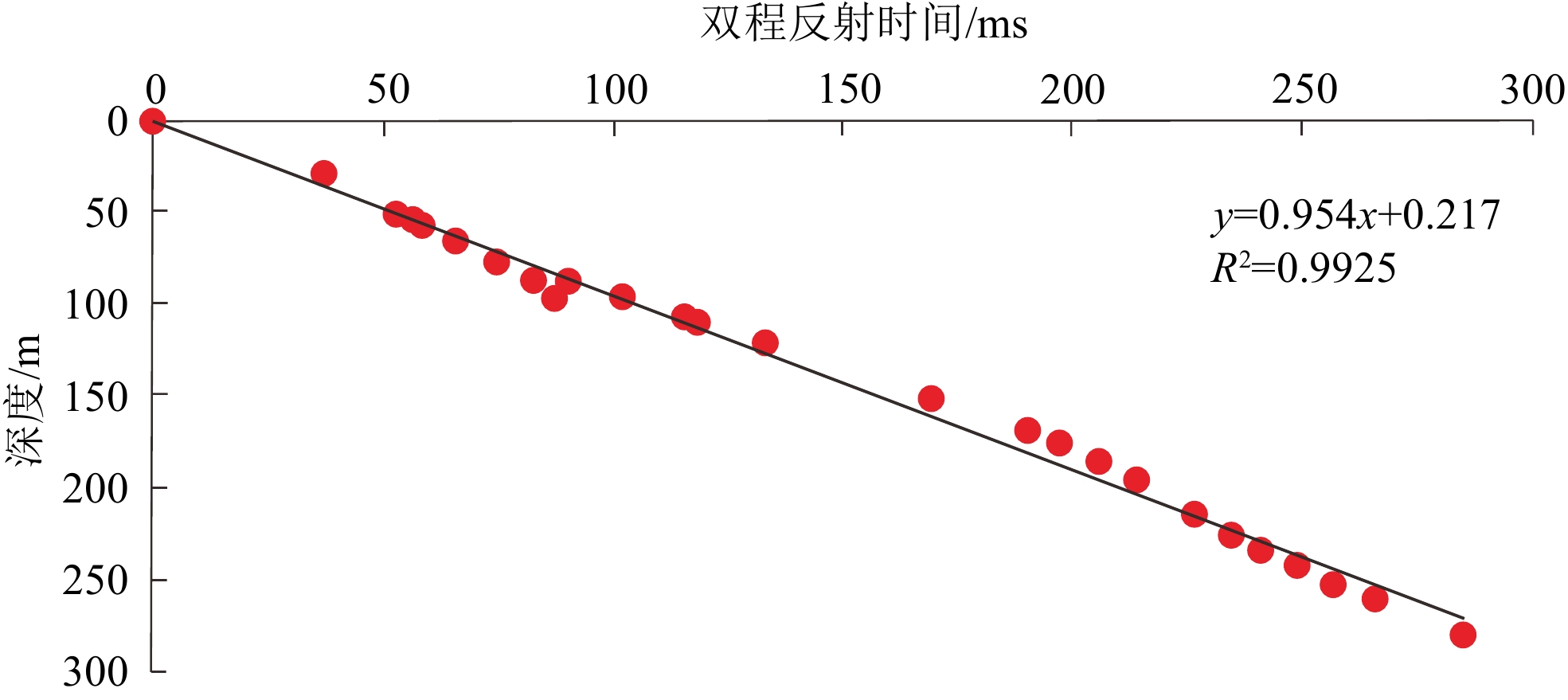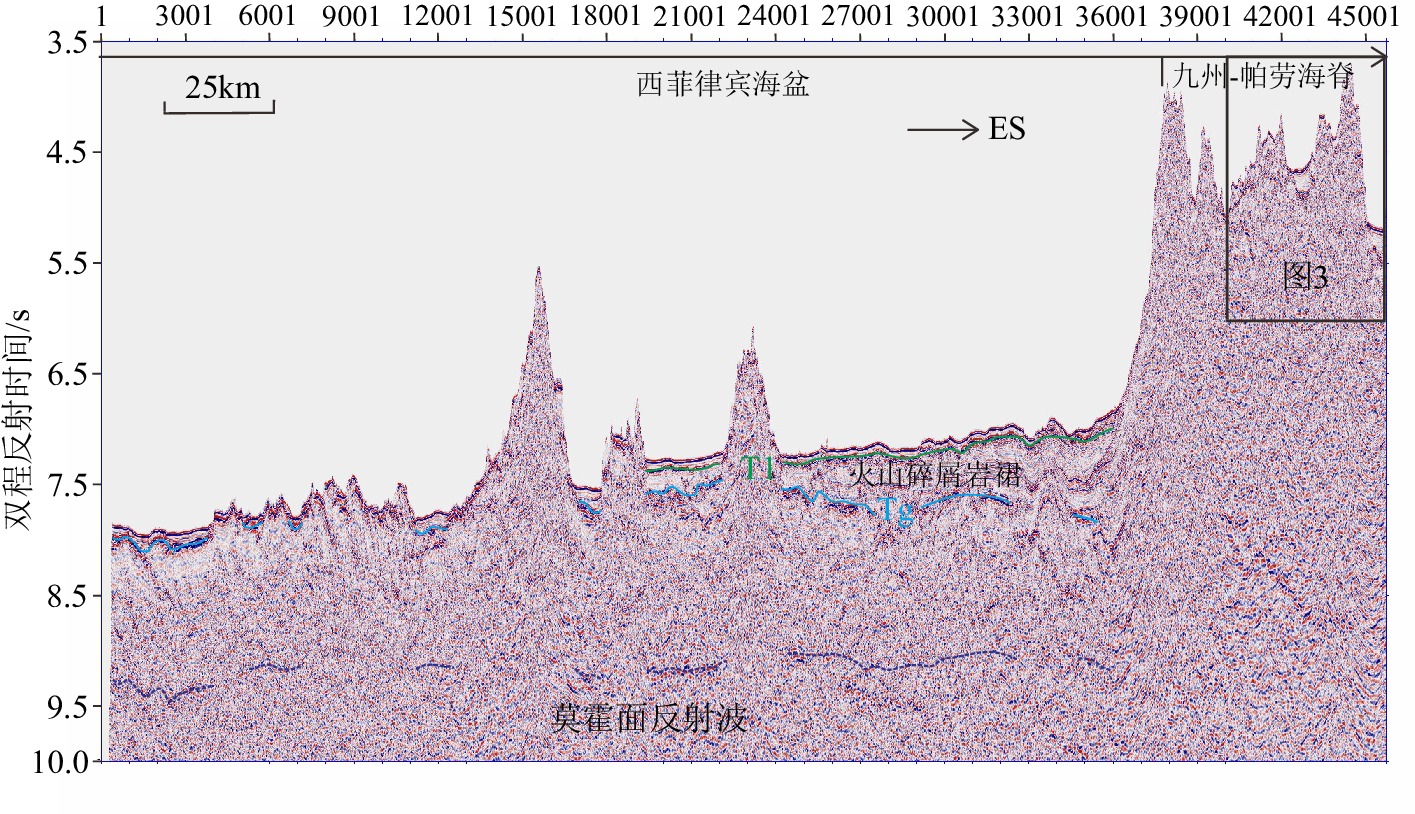Tectono-sedimentary characteristics and subduction initiation in the middle Kyushu-Palau Ridge and adjacent basins: A comprehensive study of multichannel seismic reflection profiles
-
摘要: 九州-帕劳海脊及两侧的盆地是研究边缘海形成演化和板块俯冲起始机制的理想区域。利用最新采集的深反射地震数据并结合钻孔数据,研究了九州-帕劳海脊及其东西两侧盆地的构造沉积特征及地壳结构,探讨了西菲律宾海的起源及沿古伊豆-博宁-马里亚纳弧的俯冲起始机制。地震剖面和钻孔岩心揭示西菲律宾海盆发育上、下两套不同来源的沉积物盖层,其中下部地层厚度差别大,多为火山物质,来源于九州-帕劳海脊的岛弧火山作用,表现为向海脊方向的持续增厚,靠近海脊的山脚下发育火山碎屑岩裙;上部地层厚度较为稳定,为一套大洋的深水细粒沉积物。西菲律宾海盆和帕里西维拉海盆的地壳厚度约为6~8 km,接近全球平均洋壳厚度;西菲律宾海盆的莫霍面呈宽缓的褶皱状,与沉积物之下的洋壳基底基本同步起伏。西菲律宾海盆在中生代可能位于南半球澳大利亚的北缘,是在陆缘弧(包含部分大陆碎片)的基础上,因古近纪弧间伸展和海底扩张而逐步发展起来的。西菲律宾海盆的地震剖面和钻井均揭示了始新世时期的构造挤压事件,沿古伊豆-博宁-马里亚纳弧的俯冲起始可能是印亚碰撞的远场效应引起的诱导俯冲,俯冲过程伴随着侧向传播和持续的挤压应力场,直到约30 Ma开始岛弧裂离。该研究对揭示东南亚板块构造演化过程和板块俯冲起始机制具有一定的理论意义。Abstract: The Kyushu Palau Ridge and the basins on the both sides are ideal areas for understanding the formation and evolution of marginal seas and the initiation mechanism of plate subduction. We studied the tectonic sedimentary characteristics and crustal structure of the Kyushu-Palau Ridge (KPR) and adjacent basins using newly collected deep reflection seismic data combined with the borehole data, and discussed the origin and subduction initiation mechanism of the West Philippines Sea. Seismic profiles and drill cores revealed that two sets of sediment caprocks are developed from different sources in the Western Philippines Basin. The thickness of the lower set is very different, and most of them are volcanic materials that derived from island arc volcanos of KPR, showing continuous thickening towards KPR, and volcanoclastic rock skirts are developed near the foot of KPR. The thickness of the upper set is relatively stable, being composed of deep-water fine-grained sediments. The crust thickness of the western Philippines Basin and Parece Vela Basin is 6-8km, which is similar to the global average oceanic crust thickness. The Moho surface of the Western Philippines Basin is in a wide-gentle fold shape, and fluctuates synchronously with the ocean crust basement beneath sediments. The Western Philippines Basin might be located in the northern margin of Australia in the southern hemisphere in the Mesozoic, and was gradually developed on a continental margin arc (including some continental fragments) due to inter-arc extension and submarine spreading in the Paleogene. Seismic profiles and drilling in the Western Philippines Basin have revealed tectonic compression events during the Eocene. The subduction along the paleo-IBM (Izu-Bonin-Mariana) might be induced by the remote effect of the Indo-Asian collision. The subduction process was accompanied by lateral propagation and persistent compressive stress field, which consequently resulted in the island arc broke up in about 30Ma. This study has certain theoretical significance for studying the plate tectonic evolution and subduction initiation mechanism in Southeast Asia.
-
-
图 1 菲律宾海构造简图
底图由Global Mapper软件制作,高程数据来自http://www.ngdc.noaa.gov/mgg/global/global.html,磁条带数据据文献[12]。
Figure 1. Tectonic setting of the Philippine Sea
The base map was drawn by Global Mapper software and elevation data was from http://www.ngdc.noaa.gov/mgg /global/global.html. Magnetic bands data are from reference [12].
-
[1] Seno T, Maruyama S. Paleogeographic reconstruction and origin of the Philippine Sea [J]. Tectonophysics, 1984, 102(1-4): 53-84. doi: 10.1016/0040-1951(84)90008-8
[2] Hall R, Ali J R, Anderson C D, et al. Origin and motion history of the Philippine Sea Plate [J]. Tectonophysics, 1995, 251(1-4): 229-250. doi: 10.1016/0040-1951(95)00038-0
[3] Hall R. Cenozoic geological and plate tectonic evolution of SE Asia and the SW Pacific: computer-based reconstructions, model and animations [J]. Journal of Asian Earth Sciences, 2002, 20(4): 353-431. doi: 10.1016/S1367-9120(01)00069-4
[4] Pubellier M, Ali J, Monnier C. Cenozoic Plate interaction of the Australia and Philippine Sea Plates: “hit-and-run” tectonics [J]. Tectonophysics, 2003, 363(3-4): 181-199. doi: 10.1016/S0040-1951(02)00671-6
[5] Yamazaki T, Takahashi M, Iryu Y, et al. Philippine Sea Plate motion since the Eocene estimated from paleomagnetism of seafloor drill cores and gravity cores [J]. Earth, Planets and Space, 2010, 62(6): 495-502. doi: 10.5047/eps.2010.04.001
[6] Wu J, Suppe J, Lu R Q, et al. Philippine Sea and East Asian plate tectonics since 52Ma constrained by new subducted slab reconstruction methods [J]. Journal of Geophysical Research:Solid Earth, 2016, 121(6): 4670-4741. doi: 10.1002/2016JB012923
[7] Arculus R J, Ishizuka O, Bogus K A, et al. A record of spontaneous subduction initiation in the Izu-Bonin-Mariana arc [J]. Nature Geoscience, 2015, 8(9): 728-733. doi: 10.1038/ngeo2515
[8] Stern R J, Gerya T. Subduction initiation in nature and models: a review [J]. Tectonophysics, 2018, 746: 173-198. doi: 10.1016/j.tecto.2017.10.014
[9] 丁巍伟, 李家彪. 九州-帕劳海脊南段的深部结构探测及对板块俯冲起始机制的可能启示[J]. 海洋地质与第四纪地质, 2019, 39(5):98-103 DING Weiwei, LI Jiabiao. Seismic detection of deep structure for Southern Kyueshu-Palau Ridge and its possible implications for subduction initiation [J]. Marine Geology & Quaternary Geology, 2019, 39(5): 98-103.
[10] Sun W D, Zhang L P, Li H, et al. The synchronic Cenozoic subduction initiations in the west Pacific induced by the closure of the neo-Tethys ocean [J]. Science Bulletin, 2020, 65(24): 2068-2071. doi: 10.1016/j.scib.2020.09.001
[11] Li H, Arculus R J, Ishizuka O, et al. Basalt derived from highly refractory mantle sources during early Izu-Bonin-Mariana arc development [J]. Nature Communications, 2021, 12: 1723. doi: 10.1038/s41467-021-21980-0
[12] Sasaki T, Yamazaki T, Ishizuka O. A revised spreading model of the West Philippine Basin [J]. Earth, Planets and Space, 2014, 66: 83. doi: 10.1186/1880-5981-66-83
[13] 吴时国, 范建柯, 董冬冬. 论菲律宾海板块大地构造分区[J]. 地质科学, 2013, 48(3):677-692 doi: 10.3969/j.issn.0563-5020.2013.03.008 WU Shiguo, FAN Jianke, DONG Dongdong. Discussion on the tectonic division of the Philippine Sea Plate [J]. Chinese Journal of Geology, 2013, 48(3): 677-692. doi: 10.3969/j.issn.0563-5020.2013.03.008
[14] Mrozowski C L, Lewis S D, Hayes D E. Complexities in the tectonic evolution of the West Philippine Basin [J]. Tectonophysics, 1982, 82(1-2): 1-24. doi: 10.1016/0040-1951(82)90085-3
[15] Hilde T W C, Lee C S. Origin and evolution of the west Philippine Basin: A new interpretation [J]. Tectonophysics, 1984, 102(1-4): 85-104. doi: 10.1016/0040-1951(84)90009-X
[16] 张国良, 王帅, 张吉, 等. 西太平洋若干沟-弧-盆体系及板内岩浆成因研究进展[J]. 海洋与湖沼, 2017, 48(6):1220-1234 ZHANG Guoliang, WANG Shuai, ZHANG Ji, et al. Proceedings of subduction system and intra-oceanic volcanism of the western Pacific [J]. Oceanologia et Limnologia Sinica, 2017, 48(6): 1220-1234.
[17] Ozima M, Kaneoka I, Ujiie H. 40Ar-39Ar age of rocks, and the development mode of the Philippine Sea [J]. Nature, 1977, 267(5614): 816-818. doi: 10.1038/267816a0
[18] Sutter J F, Snee L W. K/Ar and 40Ar/39Ar dating of basaltic rocks from Deep Sea Drilling Project Leg 59 [J]. Am. Geophys. Union, 1978, 59: 729-734.
[19] Mrozowski C L, Hayes D E. The evolution of the Parece Vela Basin, Eastern Philippine Sea [J]. Earth and Planetary Science Letters, 1979, 46(1): 49-67. doi: 10.1016/0012-821X(79)90065-7
[20] Mills W. Analysis of conglomerates and associated sedimentary rocks of the Daito Ridge, Deep Sea Drilling Project Site 445[R]. Init. Rep. Deep Sea Drill. Proj. 1980: 643-657.
[21] Hall C E, Gurnis M, Sdrolias M, et al. Catastrophic initiation of subduction following forced convergence across fracture zones [J]. Earth and Planetary Science Letters, 2003, 212(1-2): 15-30. doi: 10.1016/S0012-821X(03)00242-5
[22] Murauchi S, Den N, Asano S, et al. Crustal structure of the Philippine Sea [J]. Journal of Geophysical Research, 1968, 73(10): 3143-3171. doi: 10.1029/JB073i010p03143
[23] Rodnikov A G. Deep structure of the tectonosphere in the West Equatorial Pacific margin [J]. Journal of Southeast Asian Earth Sciences, 1991, 6(3-4): 201-208. doi: 10.1016/0743-9547(91)90067-8
[24] Nishizawa A, Kaneda K, Katagiri Y, et al. Variation in crustal structure along the Kyushu-Palau Ridge at 15-21°N on the Philippine Sea plate based on seismic refraction profiles [J]. Earth, Planets and Space, 2007, 59(6): e17-e20. doi: 10.1186/BF03352711
[25] Uyeda S, Ben-Avraham Z. Origin and development of the Philippine Sea [J]. Nature Physical Science, 1972, 240(104): 176-178. doi: 10.1038/physci240176a0
[26] Karig D E. Origin and development of marginal basins in the western Pacific [J]. Journal of Geophysical Research, 1971, 76(11): 2542-2561. doi: 10.1029/JB076i011p02542
[27] Hickey-Vargas R. Basalt and tonalite from the Amami Plateau, northern west Philippine Basin: New Early Cretaceous ages and geochemical results, and their petrologic and tectonic implications [J]. The Island Arc, 2005, 14(4): 653-665. doi: 10.1111/j.1440-1738.2005.00474.x
[28] Ishizuka O, Tani K, Reagan M K, et al. The timescales of subduction initiation and subsequent evolution of an oceanic island arc [J]. Earth and Planetary Science Letters, 2011, 306(3-4): 229-240. doi: 10.1016/j.jpgl.2011.04.006
[29] Tani K, Ishizuka O, Ueda H, et al. Izu-Bonin arc: intra-oceanic from the beginning? Unraveling the crustal structure of the Mesozoic proto-Philippine Sea Plate[C]//Proceedings of the AGU Fall Meeting 2012. Washington, D. C. : AGU, 2012.
[30] Hall R. The subduction initiation stage of the Wilson cycle [J]. Geological Society, London, Special Publications, 2019, 470(1): 415-437. doi: 10.1144/SP470.3
[31] Tokuyama H. Origin and development of the Philippine Sea[M]//Tokuyama H, Sheheka N, Isezaki N, et al. Geology and Geophysics of the Philippine Sea. Tokyo: Terrra Science Publisher, 1995: 155-163.
[32] Matsuda J, Zashu S, Oziam M. Sr isotope studies of volcanic rocks from island arcs in the western Pacific [J]. Tectonophysics, 1977, 37: 141-151. doi: 10.1016/0040-1951(77)90044-0
[33] Deschamps A, Monié P, Lallemand S, et al. Evidence for Early Cretaceous oceanic crust trapped in the Philippine Sea Plate [J]. Earth and Planetary Science Letters, 2000, 179(3-4): 503-516. doi: 10.1016/S0012-821X(00)00136-9
[34] Qian S P, Zhang X Z, Wu J, et al. First identification of a Cathaysian continental fragment beneath the Gagua Ridge, Philippine Sea, and its tectonic implications [J]. Geology, 2021, 49(11): 1332-1336. doi: 10.1130/G48956.1
[35] Hall R, Nichols G J. Terrane amalgamation in the Philippine Sea margin [J]. Tectonophysics, 1990, 181(1-4): 207-222. doi: 10.1016/0040-1951(90)90017-3
[36] Yumul G P Jr. Westward younging disposition of Philippine ophiolites and its implication for arc evolution [J]. Island Arc, 2007, 16(2): 306-317. doi: 10.1111/j.1440-1738.2007.00573.x
[37] Lewis S D, Hayes D E, Mrozowski C L. The origin of the West Philippine Basin by inter-arc spreading[M]//Balce G R, Zanoria A S. Geology and Tectonics of the Luzon-Marianas Region: Philippine Seatar Committee Special Publication, 1982, 1: 31-51.
[38] Lallemand S, Arcay D. Subduction initiation from the earliest stages to self-sustained subduction: Insights from the analysis of 70 Cenozoic sites [J]. Earth-Science Reviews, 2021, 221: 103779. doi: 10.1016/j.earscirev.2021.103779
[39] Stern R J. Subduction initiation: spontaneous and induced [J]. Earth and Planetary Science Letters, 2004, 226(3-4): 275-292. doi: 10.1016/S0012-821X(04)00498-4
[40] Shemenda A I. Horizontal lithosphere compression and subduction: constraints provided by physical modeling [J]. Journal of Geophysical Research:Solid Earth, 1992, 97(B7): 11097-11116. doi: 10.1029/92JB00177
[41] Deschamps A, Lallemand S. The West Philippine Basin: An Eocene to early Oligocene back arc basin opened between two opposed subduction zones [J]. Journal of Geophysical Research:Solid Earth, 2002, 107(B12): 2322.
[42] Leng W, Gurnis M. Subduction initiation at relic arcs [J]. Geophysical Research Letters, 2015, 42(17): 7014-7021. doi: 10.1002/2015GL064985
[43] Ribeiro J M, Stern R J, Kelley K A, et al. Composition of the slab-derived fluids released beneath the Mariana forearc: evidence for shallow dehydration of the subducting plate [J]. Earth and Planetary Science Letters, 2015, 418: 136-148. doi: 10.1016/j.jpgl.2015.02.018




 下载:
下载:









